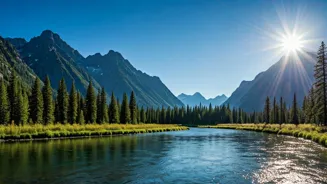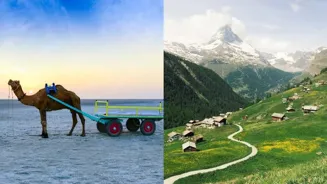Introduction to Sapta Puri
The 'Sapta Puri' holds a significant place within Hinduism, representing seven cities considered exceptionally sacred. These locations are not just geographical
points; they are believed to be gateways to moksha, or liberation from the cycle of rebirth. Pilgrims from all over India and beyond travel to these cities, seeking spiritual solace and a deeper understanding of their faith. Each city has a unique mythological history, associated with various deities and significant events. The act of visiting these places is viewed as a purification ritual, cleansing the soul and paving the way for a closer connection to the divine. These cities also serve as centers of learning, culture, and tradition, with temples, ashrams, and various religious practices shaping the daily lives of residents and visitors alike.
Ayodhya: The Birthplace
Ayodhya is one of the most important among the Sapta Puri. It is revered as the birthplace of Lord Rama, the central figure in the epic Ramayana. The city's historical significance dates back centuries, filled with stories of epic battles, divine interventions, and royal dynasties. Today, Ayodhya continues to be a major pilgrimage site, drawing countless devotees seeking blessings. The Ram Mandir, built at the site believed to be Lord Rama's birthplace, stands as a symbol of faith and devotion. Visitors often perform specific rituals and participate in various religious ceremonies. The city’s atmosphere is charged with spirituality, as chants and prayers echo throughout the narrow lanes, especially during major festivals such as Ram Navami. Exploring Ayodhya provides a deep connection to the roots of Indian culture and the enduring legacy of Lord Rama.
Mathura: The Krishna Land
Mathura is the sacred city associated with Lord Krishna's birth and childhood. Located on the banks of the Yamuna River, Mathura is filled with temples and historical sites that celebrate Krishna's playful and divine nature. The city hosts numerous festivals, especially during Janmashtami, which draws large crowds. Pilgrims visit the Krishna Janmabhoomi Temple, believed to be the exact location where Krishna was born. Other important sites include the Dwarkadhish Temple and the various ghats along the Yamuna, where devotees take ritual baths. The culture in Mathura is vibrant with colors, music, and dance, especially the Raslila performances, which depict Krishna's life and leelas. A visit to Mathura is a step into the realm of Krishna's love and devotion, making it an essential stop on the spiritual journey.
Haridwar: The Gateway
Haridwar, situated in the foothills of the Himalayas, is the gateway to the Char Dham pilgrimage and offers a unique blend of spirituality and natural beauty. The city is a major Hindu pilgrimage site, where the sacred river Ganges flows into the plains. Every day, thousands of devotees gather at the Har Ki Pauri ghat to participate in the Ganga Aarti, a beautiful evening ritual of prayers and offerings to the river goddess. The Kumbh Mela, one of the largest religious gatherings in the world, is held in Haridwar every twelve years, drawing millions of pilgrims from around the globe. Haridwar provides a sense of peace and an opportunity to connect with the divine. This destination is considered a place of cleansing, where one can wash away sins and gain spiritual growth.
Kashi: The Eternal City
Kashi, also known as Varanasi, is one of the oldest living cities in the world and is considered the spiritual capital of India. Located on the banks of the Ganges River, it's believed that those who die in Kashi attain moksha. The city is famed for its numerous ghats, where rituals are performed and bodies are cremated, as well as its ancient temples like the Kashi Vishwanath Temple, dedicated to Lord Shiva. Kashi is characterized by its narrow lanes, the constant sound of bells, and the scent of incense. The atmosphere in Kashi is profoundly spiritual, offering a unique experience for travelers seeking to understand life and death. Walking through the city feels like stepping back in time, connecting with a tradition that has been going on for centuries.
Ujjain: The Abode
Ujjain is a historical city famous for its Mahakaleshwar Jyotirlinga temple, dedicated to Lord Shiva, and one of the twelve Jyotirlingas. The city also hosts the Simhastha Kumbh Mela, a major Hindu festival held every 12 years. Ujjain is rich in history and mythology, with numerous ancient temples and historical sites. The city is also known for its ancient astronomical observatory, which continues to be a center of knowledge. Pilgrims and tourists visit Ujjain to experience its deep spiritual atmosphere and participate in the religious rituals. Exploring the city is an immersive experience that allows you to step into India’s ancient wisdom.
Dwaraka: The Kingdom
Dwaraka, located on the western coast of Gujarat, is believed to be the ancient kingdom of Lord Krishna. This coastal city is important in Hindu mythology, housing the Dwarkadhish Temple, a significant pilgrimage site. Dwaraka is famed for its unique architecture, temples, and pristine beaches. The city's location on the Arabian Sea gives it a distinctive charm and beauty. A boat ride to the submerged ancient city of Dwaraka is one of the major attractions. Pilgrims and tourists flock here to explore the city’s religious sites and experience the serene coastal atmosphere. Visiting Dwaraka is a journey into the rich history and divine essence of Lord Krishna's time.















